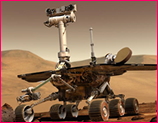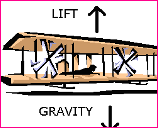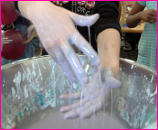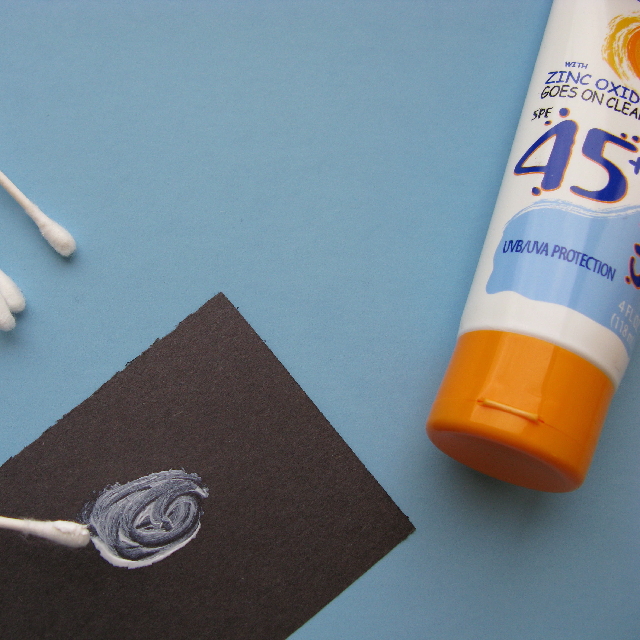Posted on April 3rd, 2011 by Mary Lord
 In this activity, students will learn the challenges of operating a robotic rover on the distant Red Planet and solve problems through a hands-on simulation. After trying to navigate an obstacle course blindfolded and guided only by verbal commands, students will discover that tooling around Mars is no simple joy-stick ride.
In this activity, students will learn the challenges of operating a robotic rover on the distant Red Planet and solve problems through a hands-on simulation. After trying to navigate an obstacle course blindfolded and guided only by verbal commands, students will discover that tooling around Mars is no simple joy-stick ride.
Read More
Filed under: Grades 6-8, Grades K-5, Lesson Plans | Comments Off on Mars Rover Races
Tags: Class Activities, Lesson Plan, Lesson Plans, NASA, Robotics
Posted on March 27th, 2011 by ASEE
 In this lesson, you’ll introduce your students to the four forces of flight–drag, lift, thrust, and weight–through a variety of fun-filled flight experiments. Students will “fly” for short periods and then evaluate factors that might either increase or decrease their “flight” duration.
In this lesson, you’ll introduce your students to the four forces of flight–drag, lift, thrust, and weight–through a variety of fun-filled flight experiments. Students will “fly” for short periods and then evaluate factors that might either increase or decrease their “flight” duration.
Read More
Filed under: Class Activities, Grades 6-8, Grades 6-8, Grades K-5, Grades K-5, Lesson Plans | 1 Comment »
Tags: Aerodynamics, Aeronautics, Class Activities, Lesson Plan, Physics
Posted on March 27th, 2011 by Mary Lord
 It’s easy to find your way to school. Now imagine trying to navigate the skies, with no signs to point you in the right direction. How do pilots find their way? These “pilot training lessons” developed by the Center for Innovation in Engineering and Science Education at the Stevens Institute of Technology will teach your young aviators the principles of navigation in a fun series of real-time activities.
It’s easy to find your way to school. Now imagine trying to navigate the skies, with no signs to point you in the right direction. How do pilots find their way? These “pilot training lessons” developed by the Center for Innovation in Engineering and Science Education at the Stevens Institute of Technology will teach your young aviators the principles of navigation in a fun series of real-time activities.
Read More
Filed under: Class Activities, Grades 6-8, Grades 6-8, Grades 9-12, Grades K-5, Lesson Plans, Web Resources | 2 Comments »
Tags: Aeronautics, Aerospace, airplane, Class Activities, flight, Grades 6-8, Lesson Plan, Mathematics, NASA, Physics, vectors, windspeed
Posted on March 25th, 2011 by Mary Lord
 In this lesson, you’ll introduce your students to the four forces of flight — drag, lift, thrust, and weight — through a variety of fun flight experiments. Students will “fly” for short periods and then evaluate factors that might either increase or decrease their “flight” duration. They also will discover how air moving at different speeds over a wing keeps planes aloft.
In this lesson, you’ll introduce your students to the four forces of flight — drag, lift, thrust, and weight — through a variety of fun flight experiments. Students will “fly” for short periods and then evaluate factors that might either increase or decrease their “flight” duration. They also will discover how air moving at different speeds over a wing keeps planes aloft.
Read More
Filed under: Grades 6-8, Grades 9-12, Lesson Plans | 1 Comment »
Tags: Aerodynamics, Aeronautics, Aerospace, Lesson Plan, Lesson Plans
Posted on March 20th, 2011 by Mary Lord
 Basketball not only is fun to play or watch–it packs a lot of math and science in each move. In this lesson, developed by NPR’s Talking Science with John Fontanella, a physicist at the U.S. Naval Academy and author of The Physics of Basketball, students will learn how physics affects the game. What forces are acting on the ball? What must players do to offset these forces?
Basketball not only is fun to play or watch–it packs a lot of math and science in each move. In this lesson, developed by NPR’s Talking Science with John Fontanella, a physicist at the U.S. Naval Academy and author of The Physics of Basketball, students will learn how physics affects the game. What forces are acting on the ball? What must players do to offset these forces?
Read More
Filed under: Class Activities, Grades 6-8, Grades 6-8, Lesson Plans | Comments Off on Lesson: Free Shot Physics
Tags: Class Activities, Grades 6-8, Lesson Plan, Lesson Plans, Physics
Posted on March 6th, 2011 by Mary Lord
 From the “miracle fiber” Kevlar invented by Dupont chemist Stephanie Kwolek to Silly Putty, our world abounds with materials discovered by accident. In this activity from the Society of Women Engineers (SWE), students will learn some serious materials science–and hit several national science and tehcnology standards–by using everyday items to create and investigate the properties of Funny Putty.
From the “miracle fiber” Kevlar invented by Dupont chemist Stephanie Kwolek to Silly Putty, our world abounds with materials discovered by accident. In this activity from the Society of Women Engineers (SWE), students will learn some serious materials science–and hit several national science and tehcnology standards–by using everyday items to create and investigate the properties of Funny Putty.
Read More
Filed under: Class Activities, Grades 6-8, Grades 6-8, Grades K-5, Grades K-5, Lesson Plans | 1 Comment »
Tags: Class Activities, Curriculum, Lesson Plan, Lesson Plans, Slime
Posted on February 28th, 2011 by ASEE
In this project, students in grades 6-12 will recreate the remarkable measurement of the circumference of the earth first performed over 2,000 years ago. Using rulers, protractors, and meter sticks, students measure shadows cast by a stick on a day close to the equinox, then use that measurement in a simple equation to determine the circumference.
Read More
Filed under: Grades 6-8, Grades 9-12, Lesson Plans | 1 Comment »
Tags: Earth Science, Geometry, Mathematics
Posted on February 20th, 2011 by ASEE
 In this quick, hands-on lesson, students in grades K-12 compare sunblock containing nanoparticles to those that do not and learn how nanoparticles are used to help block harmful rays from the sun.
In this quick, hands-on lesson, students in grades K-12 compare sunblock containing nanoparticles to those that do not and learn how nanoparticles are used to help block harmful rays from the sun.
Read More
Filed under: Grades 6-8, Grades 9-12, Grades K-5, Lesson Plans | 1 Comment »
Tags: Grades K-12, Lesson Plan, Nanodays, Nanotechnology
Posted on February 6th, 2011 by ASEE
 In this lesson, students in grades 6-12 use simple materials to design, build, and test a model of a free-standing structure used to support overhead road signs. They begin by learning about the engineering design process and researching about support structures. They then work in groups to design and build their own sign supports. The final designs are tested to see how they stand up to two different types of loads.
In this lesson, students in grades 6-12 use simple materials to design, build, and test a model of a free-standing structure used to support overhead road signs. They begin by learning about the engineering design process and researching about support structures. They then work in groups to design and build their own sign supports. The final designs are tested to see how they stand up to two different types of loads.
Read More
Filed under: Grades 6-8, Grades 9-12, Lesson Plans | 1 Comment »
Tags: Architectural, Civil Engineering, Engineering Design, Engineering Design Process, Grades 6-12, Lesson Plan, Transportation
 In this activity, students will learn the challenges of operating a robotic rover on the distant Red Planet and solve problems through a hands-on simulation. After trying to navigate an obstacle course blindfolded and guided only by verbal commands, students will discover that tooling around Mars is no simple joy-stick ride.
In this activity, students will learn the challenges of operating a robotic rover on the distant Red Planet and solve problems through a hands-on simulation. After trying to navigate an obstacle course blindfolded and guided only by verbal commands, students will discover that tooling around Mars is no simple joy-stick ride. 








 In this lesson, you’ll introduce your students to the four forces of flight–drag, lift, thrust, and weight–through a variety of fun-filled flight experiments. Students will “fly” for short periods and then evaluate factors that might either increase or decrease their “flight” duration.
In this lesson, you’ll introduce your students to the four forces of flight–drag, lift, thrust, and weight–through a variety of fun-filled flight experiments. Students will “fly” for short periods and then evaluate factors that might either increase or decrease their “flight” duration. It’s easy to find your way to school. Now imagine trying to navigate the skies, with no signs to point you in the right direction. How do pilots find their way? These “pilot training lessons” developed by the Center for Innovation in Engineering and Science Education at the Stevens Institute of Technology will teach your young aviators the principles of navigation in a fun series of real-time activities.
It’s easy to find your way to school. Now imagine trying to navigate the skies, with no signs to point you in the right direction. How do pilots find their way? These “pilot training lessons” developed by the Center for Innovation in Engineering and Science Education at the Stevens Institute of Technology will teach your young aviators the principles of navigation in a fun series of real-time activities. In this lesson, you’ll introduce your students to the four forces of flight — drag, lift, thrust, and weight — through a variety of fun flight experiments. Students will “fly” for short periods and then evaluate factors that might either increase or decrease their “flight” duration. They also will discover how air moving at different speeds over a wing keeps planes aloft.
In this lesson, you’ll introduce your students to the four forces of flight — drag, lift, thrust, and weight — through a variety of fun flight experiments. Students will “fly” for short periods and then evaluate factors that might either increase or decrease their “flight” duration. They also will discover how air moving at different speeds over a wing keeps planes aloft. Basketball not only is fun to play or watch–it packs a lot of math and science in each move. In this lesson, developed by NPR’s Talking Science with John Fontanella, a physicist at the U.S. Naval Academy and author of The Physics of Basketball, students will learn how physics affects the game. What forces are acting on the ball? What must players do to offset these forces?
Basketball not only is fun to play or watch–it packs a lot of math and science in each move. In this lesson, developed by NPR’s Talking Science with John Fontanella, a physicist at the U.S. Naval Academy and author of The Physics of Basketball, students will learn how physics affects the game. What forces are acting on the ball? What must players do to offset these forces?  From the “miracle fiber” Kevlar invented by Dupont chemist Stephanie Kwolek to Silly Putty, our world abounds with materials discovered by accident. In this activity from the Society of Women Engineers (SWE), students will learn some serious materials science–and hit several national science and tehcnology standards–by using everyday items to create and investigate the properties of Funny Putty.
From the “miracle fiber” Kevlar invented by Dupont chemist Stephanie Kwolek to Silly Putty, our world abounds with materials discovered by accident. In this activity from the Society of Women Engineers (SWE), students will learn some serious materials science–and hit several national science and tehcnology standards–by using everyday items to create and investigate the properties of Funny Putty. In this quick, hands-on lesson, students in grades K-12 compare sunblock containing nanoparticles to those that do not and learn how nanoparticles are used to help block harmful rays from the sun.
In this quick, hands-on lesson, students in grades K-12 compare sunblock containing nanoparticles to those that do not and learn how nanoparticles are used to help block harmful rays from the sun. In this lesson, students in grades 6-12 use simple materials to design, build, and test a model of a free-standing structure used to support overhead road signs. They begin by learning about the engineering design process and researching about support structures. They then work in groups to design and build their own sign supports. The final designs are tested to see how they stand up to two different types of loads.
In this lesson, students in grades 6-12 use simple materials to design, build, and test a model of a free-standing structure used to support overhead road signs. They begin by learning about the engineering design process and researching about support structures. They then work in groups to design and build their own sign supports. The final designs are tested to see how they stand up to two different types of loads.